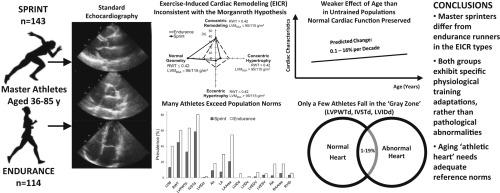Journal of the American Society of Echocardiography ( IF 5.4 ) Pub Date : 2021-06-24 , DOI: 10.1016/j.echo.2021.06.009 Krzysztof Kusy 1 , Jan Błażejewski 2 , Wojciech Gilewski 2 , Danuta Karasek 2 , Joanna Banach 2 , Robert Bujak 2 , Jacek Zieliński 1 , Władysław Sinkiewicz 2 , Grzegorz Grześk 2

|
Background
Sports training triggers exercise-induced cardiac remodeling (EICR). Sprint- and endurance-trained master athletes are exposed to different hemodynamic stimuli accompanied by aging. The aim of this study was to compare EICR types in light of the Morganroth hypothesis, frequency of abnormalities, and relationships between cardiac traits and age.
Methods
In this observational cross-sectional study, echocardiographic examinations were conducted in 143 sprint-trained (age range, 36–83 years) and 114 endurance-trained (age range, 38–85 years) competitive master athletes. Structural and functional characteristics were compared with population reference values, and EICR types were identified. Athletic groups were compared using t tests and χ2 tests. Relationships with age were assessed using linear regression.
Results
In the sprint group, 51.0% of athletes had normal cardiac geometry (nonhypertrophic heart), 4.2% had eccentric hypertrophy, 36.4% had concentric remodeling, and 8.4% had concentric hypertrophy. In their endurance-trained peers, these proportions were 22.8%, 16.7%, 36.8%, and 23.7%, respectively. Many athletes in both groups had structural abnormalities, as assessed using population norms (up to ~81% for septal thickness) but their resting cardiac function was normal. The relationships of structural and functional cardiac characteristics with age were mostly weak to moderate and did not differ between training modalities.
Conclusions
Even though many endurance- and sprint-oriented master athletes exceed population norms for cardiac structure, they do not go beyond the “gray zone” and preserve normal cardiac function. Therefore, physiologic adaptations, rather than pathologic abnormalities, are expected in aging but still active athletes. Inconsistent with the Morganroth hypothesis, EICR is shifted toward normal geometry in sprinters and toward concentric remodeling and hypertrophy in endurance runners. A better understanding of the mechanisms behind cardiac remodeling during aging is needed to adequately predict EICR types in master athletes.
中文翻译:

老化运动员的心脏:竞争性短跑与耐力训练的大师级运动员的超声心动图评估
背景
运动训练会触发运动诱发的心脏重塑 (EICR)。受过短跑和耐力训练的优秀运动员会暴露于不同的血液动力学刺激下,并伴随着衰老。本研究的目的是根据 Morganroth 假设、异常频率以及心脏特征与年龄之间的关系来比较 EICR 类型。
方法
在这项观察性横断面研究中,对 143 名接受过短跑训练(年龄范围,36-83 岁)和 114 名接受耐力训练(年龄范围,38-85 岁)的竞技高手进行了超声心动图检查。将结构和功能特征与人群参考值进行比较,并确定 EICR 类型。使用t检验和 χ 2检验比较运动组。使用线性回归评估与年龄的关系。
结果
在短跑组中,51.0% 的运动员心脏几何形状正常(非肥大心脏),4.2% 有离心肥厚,36.4% 有向心重构,8.4% 有向心性肥厚。在接受过耐力训练的同龄人中,这些比例分别为 22.8%、16.7%、36.8% 和 23.7%。两组中的许多运动员都有结构异常,如使用人群规范评估的那样(室间隔厚度高达约 81%),但他们的静息心功能正常。心脏结构和功能特征与年龄的关系大多是弱到中度的,并且在训练方式之间没有差异。
结论
尽管许多以耐力和短跑为导向的大师级运动员的心脏结构超过了人群标准,但他们并没有超出“灰色地带”并保持正常的心脏功能。因此,在衰老但仍然活跃的运动员中,预期会出现生理适应,而不是病理异常。与 Morganroth 假设不一致,EICR 在短跑运动员中转向正常几何形状,在耐力赛跑运动员中转向同心重塑和肥大。需要更好地了解衰老过程中心脏重塑背后的机制,以充分预测优秀运动员的 EICR 类型。











































 京公网安备 11010802027423号
京公网安备 11010802027423号